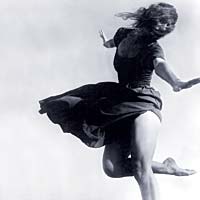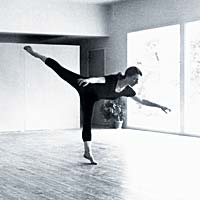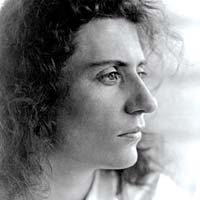|
Photos: Helen Balfour Morrison |
|
(Top) Sybil Shearer in the New York countryside ; (middle) at the studio in the late 1950s |
Sybil Shearer was not shy about her love of dance. One day in the 1960s, a trio of women retreated to the restrooms during a lunch at Chicago’s Union League Club. While her companions powdered their noses, Shearer broke into a spontaneous solo. “She didn’t feel the least bit embarrassed about prancing around the women’s restroom,” recalls Christine Du Boulay Ellis, a longtime Chicago ballet instructor, who was there.
Shearer repeatedly distinguished herself as one of the most free-spirited individuals to emerge from the early years of American modern dance. She was among the first modern performers to tackle spiritual and social justice issues, like the plight of factory workers, a theme of one piece. Her unconventional movements were often unveiled in “surprise” concerts, such as one Manhattan event attended by Gerald Arpino, now artistic director of the Joffrey Ballet. Arpino recalls that Shearer commanded a bold presence on a bare stage with only a standing light: “I was impressed by this iconoclast. She really was way out there.” After a sensational solo début at New York’s Carnegie Hall in 1941, Shearer retreated to Chicago’s suburbs, explaining that she wanted to be closer to nature. She bought a home in Northbrook with gardens designed by Jens Jensen and lived there the rest of her life, supporting herself, in part, with income from a dance studio and writing reviews. Yet she remained a major force-as a performer, teacher, and critic-until her death late last year at 93.
Even after her passing, her presence still resonates. This month marks the publication of Within This Thicket, the first part of her three-volume autobiography, and an accompanying DVD that features rare performance footage. The book and DVD are products of the Morrison-Shearer Foundation and Museum, the organization Shearer established after the 1984 death of the photographer-filmmaker Helen Morrison, her longtime collaborator and companion.
In the book, Shearer reveals much of her life through letters with such influential pen pals as Agnes de Mille and Virginia Woolf. On a personal level, she recounts her bittersweet love affair with a fellow dancer, Gerald Davidson, in the mid-1930s. Shearer writes how she and Davidson were looking at store windows along New York City’s 57th Street when he stopped in front of an auto show room and said, “I wonder when we will be able to afford one of these[.]”
The dancer says: “Suddenly I felt as though I were drowning, and my mind flew, not backward but forward-a car, a house, dishes, furniture, sheets and pillowcases, children! This was not what I intended. In a flash I looked at him, then turned and ran as fast as I could to the Seventh Avenue subway and home.”
Shearer “didn’t accept romantic overtures from anyone,” recalls James Cunning-ham, her sound engineer and music arranger. “She felt she had to devote her life to art to achieve what she wanted to achieve.” A staunch individualist, truly, or as her friend Alida Szabo, a foundation trustee, describes her, “a gentle rebel who certainly marched to her own drummer.”
Within This Thicket ($49.95, book and companion DVD) is available through mail order only: Morrison-Shearer Foundation and Museum, Box 2271, Northbrook, Illinois 60065.





